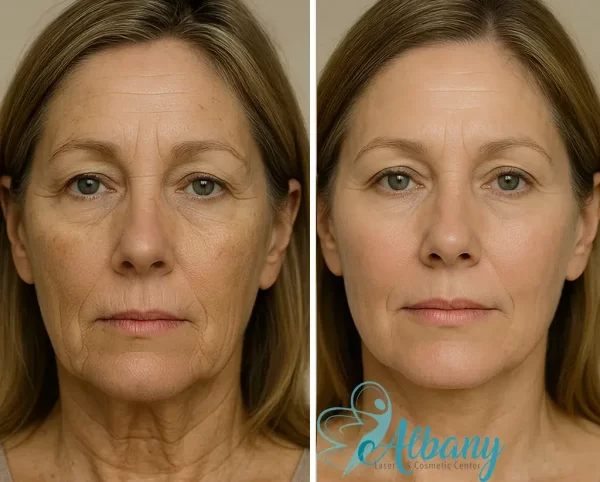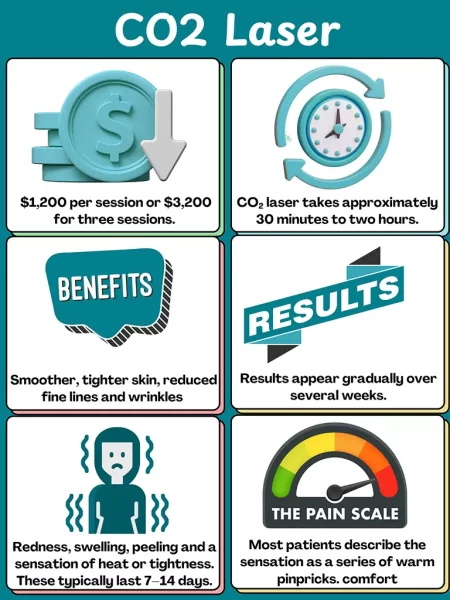Smooth, Long‑Lasting Results with CO2 Laser in Edmonton
Are you looking to reduce fine lines, wrinkles or scars and achieve smoother, younger‑looking skin? CO2 laser resurfacing, also called carbon dioxide laser treatment, uses targeted beams of light to remove damaged layers of skin. By encouraging new collagen production, this treatment can reveal a fresher, more radiant complexion. At our Edmonton clinic, certified professionals perform CO2 laser treatments tailored to your skin concerns.
Laser Resurfacing Results and Before and After Pictures


CO2 laser therapy can dramatically improve skin texture and tone. Many patients notice smoother skin, fewer wrinkles and a reduction in acne scars or sun damage. Before and after pictures from real patients highlight improvements such as tighter, more even skin and a healthy glow. Although individual results vary, most people see significant change after a single session, with continued improvement for months as collagen rebuilds.
Is CO2 Laser Right for You?
CO2 laser resurfacing is ideal for people who want to improve signs of aging, pigmentation problems, acne scars or uneven skin tone. It is most effective on lighter skin tones but advances in fractional technology allow some darker skin types to be treated safely. You should postpone treatment if you are pregnant, have taken isotretinoin in the past year or have active acne or infection in the treatment area. An in‑person consultation is necessary to determine if you’re a good candidate.
Quick Summary of CO2 Laser Resurfacing
Cost And Pricing
Procedure Duration
Treatment benefits
Expected Results
Side Effects And Downtime
Discomfort and Pain Level

How CO2 Laser Resurfacing Works
CO2 lasers emit concentrated light pulses that are absorbed by water in the skin. The heat vaporizes the epidermis while warming the underlying dermis, which stimulates collagen production and cell renewal. Fractional CO2 lasers treat microscopic columns of skin, leaving surrounding tissue intact to promote faster healing. Non‑fractional lasers remove an entire layer of skin and are better for deep wrinkles and scars but have longer downtime. Our technicians will choose the appropriate laser and settings based on your skin type and goals.
Benefits of CO2 Laser Resurfacing
This procedure offers multiple benefits:
- Smooths fine lines and wrinkles around the eyes, mouth, and forehead.
- Reduces the appearance of acne scars and surgical or traumatic scars.
- Improves skin tone by targeting sun spots, age spots, and hyperpigmentation.
- Tightens sagging skin by boosting collagen and elastin production.
- Minimizes enlarged pores and rough texture for a more polished look.
- Provides long‑lasting results that can continue to improve for months.
Preparation and Aftercare
Preparing your skin helps ensure the best results:
- Avoid tanning and unprotected sun exposure for at least two weeks before treatment.
- Discontinue photosensitizing medications and skin care products like retinoids one week prior.
- If you have a history of cold sores, take antiviral medication as prescribed.
- Stop smoking two weeks before and after treatment to aid healing.
- Arrive with clean skin and no makeup or moisturizers on the day of your procedure.
Aftercare is essential for healing:
- Keep the treated area clean using a gentle cleanser or saline solution.
- Apply the recommended ointments to keep skin moist and protect against infection.
- Use cool compresses or ice packs to reduce swelling and discomfort.
- Sleep with your head elevated to minimize swelling.
- Avoid direct sun exposure and wear broad‑spectrum sunscreen once your skin has healed.
- Refrain from wearing makeup until the skin is no longer raw or peeling, usually 7–10 days.
